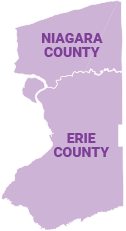Median Home Value, 2017
$135,000
 About 338,000 people live in or near poverty in Buffalo Niagara. Poverty is concentrated and most persistent in urban areas. But it’s spreading into rural and suburban areas where access to jobs and services is more limited, especially without a car. Finding ways to increase access to education and training, reduce housing cost burdens, and provide flexible transportation options are universal needs in communities across Buffalo Niagara.
About 338,000 people live in or near poverty in Buffalo Niagara. Poverty is concentrated and most persistent in urban areas. But it’s spreading into rural and suburban areas where access to jobs and services is more limited, especially without a car. Finding ways to increase access to education and training, reduce housing cost burdens, and provide flexible transportation options are universal needs in communities across Buffalo Niagara.
 Read more about the regional picture in the Numbers in Need Buffalo Niagara Regional Report which summarizes findings from our 12 community reports and presents strategies, models, and considerations for the future, including the potential ramifications of the COVID-19 pandemic.
Read more about the regional picture in the Numbers in Need Buffalo Niagara Regional Report which summarizes findings from our 12 community reports and presents strategies, models, and considerations for the future, including the potential ramifications of the COVID-19 pandemic.
Vulnerable populations, % living in poverty, 2017
Source: American Community Survey.
Source: American Community Survey.
Source: American Community Survey.
Source: American Community Survey.
Source: American Community Survey.
Source: American Community Survey.
| Rank | Employer |
|---|---|
| #1 | State of New York |
| #2 | Federal Executive Board |
| #3 | Kaleida Health |
| #4 | Catholic Health |
| #5 | Buffalo City School District |
| #6 | University at Buffalo |
| #7 | M&T Bank |
| #8 | Erie County |
| #9 | Wegmans Food Markets |
| #10 | Tops Friendly Markets |
Source: Various. See Data Sources and Notes.
| Buffalo Niagara | |
|---|---|
| Total Jobs | 547,851 |
| <$15k/yr | 150,324 (27%) |
| $15-$40k/yr | 178,599 (33%) |
| >$40k/yr | 218,928 (40%) |
Source: US Census Bureau, LEHD.
$135,000
$763/month
Over 200 human service providers and leaders use Numbers in Need to find information, build partnerships, pursue funding and advocate for their community.
“This data has been instrumental in finding what our community looks like and what obstacles we need to tackle to move ahead.”
“I have repeatedly and often share this data with colleagues and community members.”